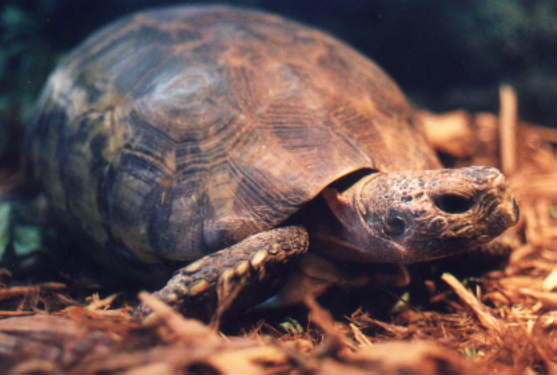Appropriate Foods for Home's Hingeback Tortoises.
If you have a Home's Hingeback that isn't eating, make sure you are heavily misting or spraying down the cage immediately before you offer food. Hingebacks are stimulated by rain to begin searching for food on the forest floor, including any mushrooms, slugs, snails, millipedes and worms that might come and search for food during the rain.If you have a new Home's hingeback, the most important thing is to get the tortoise hydrated, not food. Worry about hydration first! Once you have the tortoise properly hydrated, you can move on to food.
Mushrooms
All species of Kinixys readily devour fungi, and it is a major component of their diet in the wild. I have used all types of mushrooms available from grocery stores. Asian and/or international food markets offer the most species. Diversity is key- try everything that you can find!
Vertebrate Protein
Essentially, all tortoises are scavengers, including Home's Hingebacks. Home's hingebacks scavenge the forest floor, and they most definitely come across the carcasses of animals in the forests of Africa. Whole animal protein offers the best options for tortoises, since whole animals contain an entire suite of nutrients. Food items to try include whole feeder mice, pinky mice, beefheart, and fish like Chilean Silversides, which don't contain Thiaminase, an enzyme that prevents the uptake of Thiamine (also known as Vitamin B1).Arthropod Protein
Home's hingebacks are surely eating arthropod protein in the forests of West Africa. Commonly available food items to try include crickets, beetle larvae including super worms and meal worms, dubia roaches, and black soldier fly larvae. Millepedes are favorites in the wild with many Kinixys, but these are difficult to obtain as feeder animals. Finally, I have found that my Home's Hingebacks will readily devour whole, raw, shell, tail, and head-on shrimp. In the wild, I imagine that the forest hingeback species readily forage in the water looking for crayfish and freshwater shrimp. The chitin-rich exoskeltons of shrimp are an excellent source of calcium. Experiment with both live and freez-dried versions of all of these items.
Earthworms
Earthworms are readily consumed by Home's Hingebacks. Match the earthworm to the size of your animal. Red wigglers are quite small and are a good choice for young animals. European nightcrawlers are larger and don't require refrigeration, while Canadian nightcrawlers are the largest readily available worm on the market.
Molluscs
In my experience, slugs and snails are perhaps the best protein items to offer a picky hingeback. They devour them. Zoo Med's Can-O-Snails is an excellent product, and I also purchase frozen shell-on apple snails at our local international grocery store. I thaw them completely, then remove the meat from the shell.
Plants
You'll notice that I've waited until now to mention the most common "tortoise" food- plants. I surmise that most of the plant material that Home's Hingebacks consume in the wild is from various fruits that have fallen to the ground from above. I don't readily offer anything green to my hingebacks. Instead, I feedplant items that are actually fruits that most people consider vegetables. These include yellow squash, zucchini, pumpkin, and any of the other various squashes available in grocery stores. I will occasionally offer a sugary "fruit" to my hingebacks, but this is rare and occurs less than once per month. I will occasionally offer figs, papaya, and watermelon rinds (with much of the rind gone already).
Prepared Diets
Commercially prepared diets for reptiles are better than ever. I wouldn't expect a recent import to eat these diets, but they're worth a try. After they are established, however, they will accept these commercially prepared options. I use pelleted foods that are designed for both terrestrial turtles and tortoises. This includes Mazuri Tortoise Original, and ZooMed aquatic Turtle. What's great about Zoomed's aquatic diet is that it comes in three formulations with increasing protein- hatchling, growth, and maintenance. Other keepers have used Mazuri Aquatic Turtle Diet, and Marion Zoological's Mosaic Tortoise Diet.
Repashy, a company famous for its Crested Gecko diets, makes gelatin-based products that come in power form and require you to mix these diets. Gub Pie and Savory Stew are things to try.
-Tom
-Tom

















































